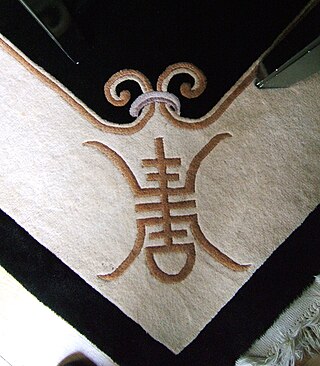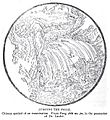
The Chinese dragon, also known as the loong, long or lung, is a legendary creature in Chinese mythology, Chinese folklore, and Chinese culture at large. Chinese dragons have many animal-like forms such as turtles and fish, but are most commonly depicted as snake-like with four legs. Academicians have identified four reliable theories on the origin of the Chinese dragon: snakes, Chinese alligators, thunder worship and nature worship. They traditionally symbolize potent and auspicious powers, particularly control over water.

Buddhist symbolism is the use of symbols to represent certain aspects of the Buddha's Dharma (teaching). Early Buddhist symbols which remain important today include the Dharma wheel, the Indian lotus, the three jewels and the Bodhi tree.

The three-leggedcrow is a mythological creature in various mythologies and arts of East Asia. It is believed to inhabit and represent the Sun.

Snuff bottles were used during the Qing dynasty to contain powdered tobacco. Smoking tobacco was illegal during the Qing dynasty, but the use of snuff was allowed because the Chinese considered snuff to be a remedy for common illnesses such as colds, headaches and stomach disorders. Therefore, snuff was carried in a small bottle like other medicines. The snuff bottle replaced the snuff box used by Europeans.

Yansheng Coins, commonly known as Chinese numismatic charms, refer to a collection of special decorative coins that are mainly used for rituals such as fortune telling, Chinese superstitions, and Feng shui. They originated during the Western Han dynasty as a variant of the contemporary Ban Liang and Wu Zhu cash coins. Over the centuries they evolved into their own commodity, with many different shapes and sizes. Their use was revitalized during the Republic of China era. Normally, these coins are privately funded and cast by a rich family for their own ceremonies, although a few types of coins have been cast by various governments or religious orders over the centuries. Chinese numismatic charms typically contain hidden symbolism and visual puns. Unlike cash coins which usually only contain two or four Hanzi characters on one side, Chinese numismatic charms often contain more characters and sometimes pictures on the same side.
Dragon robes, also known as gunlongpao or longpao for short, is a form of everyday clothing which had a Chinese dragon, called long (龍), as the main decoration; it was worn by the emperors of China. Dragon robes were also adopted by the rulers of neighbouring countries, such as Korea, Vietnam, and the Ryukyu Kingdom.

Shòu is the Chinese word/character for "longevity".

Cranes are an important motif in Chinese mythology. There are various myths involving cranes, and in Chinese mythology cranes are generally symbolically connected with the idea of longevity. In China, the crane mythology is associated with the divine bird worship in the animal totemism; cranes have a spiritual meaning where they are a form of divine bird which travels between heaven and man's world. Cranes regularly appear in Chinese arts such as paintings, tapestry, and decorative arts; they are also often depicted carrying the souls of the deceased to heaven. The crane is the second most important bird after the fenghuang, the symbol of the empress, in China.

Fish are an important motif in Chinese mythology. There are various myths involving fish. Chinese mythology refers to those myths found in the historical geographic area of China. The geographic area of "China" is of course a concept which has evolved of changed through history. Fish in Chinese mythology include myths in Chinese and other languages, as transmitted by Han Chinese as well as other officially recognized 56 minority ethnic groups in China. The Chinese word for "fish", yu, is a homophone for "abundance", "plenty", and "affluence" ; therefore, fishes are a symbol of wealth. The Chinese dragon is the head of the fish clan. The act of fishing is also an important motif in Chinese mythology and culture.

The Twelve Ornaments are a group of ancient Chinese symbols and designs that are considered highly auspicious. They were employed in the decoration of textile fabrics in ancient China, which signified authority and power, and were embroidered on vestments of state.

The Twelve Symbols national emblem was the state emblem of the Empire of China and the Republic of China from 1913 to 1928. It was based on the ancient Chinese symbols of the Twelve Ornaments.
Traditional Korean patterns are often featured throughout Korea on architecture, clothes, porcelain, necessities, and more. These patterns can be recognized either by one of the four time periods they originated from, or by their shape.

Yunjian, also known as Cloud collar in English and sometimes referred as châr-qâb, is a Chinese term which can either to a four-lobed motif, or to a traditional Chinese garment accessory item in Hanfu, the Traditional clothing of the Han Chinese, which is typically found in the form of a detachable collar with cloud patterns and is worn over the shoulders area, similar to a shawl. As an garment accessory, the yunjian is also typically found in four-lobed design although multi-lobed design also existed throughout history. The yunjian could also be applied directly on garments, where it would fall around the collar of robes onto the chest and shoulder region,or as a clothing appliqué. In China, the yunjian has both ceremonial and practical uses when used in clothing. As a garment item, the yunjian was an important clothing element for Chinese women, especially in the Ming and Qing dynasties; its usage was spread across China where it became associated with the Han Chinese's wedding clothing. In Henan, brides would wear yunjian decorated with hanging ribbons and bells. It also had the practical use of preventing clothing from being dirty and oily by covering up the clothes and by covering up the stains. The yunjian is used in Peranakan wedding; the multi-layered yunjian worn by Chinese brides on the day of their wedding is sometimes known as "phoenix collar". The yunjian also started to be worn by the Non-Chinese, the Tartars of northern China and Manchuria in the later medieval period.

Qungua, also known as longfenggua, or longfeng qungua, or guaqun, is one type of two-piece ceremonial traditional Chinese wedding set of attire, which is composed of a jacket called gua (褂) and of a long Chinese skirt called qun (裙). The qungua is a type of Hanfu worn by Han Chinese brides and originated in the 18th century during the Qing dynasty. It eventually became the traditional wedding attire of Cantonese brides in the Guangdong regions. It is traditionally handmade and is decorated with dragons and phoenixes embroideries. Nowadays, the qungua is still popular as a wedding dress in China, including in Hong kong and Macau.

Feiyufu, also called feiyu mangyi, is a type of traditional Han Chinese clothing which first appeared in the Ming dynasty. It is also specific name which generally refers to a robe decorated with the patterns of flying fish. The feiyufu worn by the Ming dynasty imperial guards reappeared in the 21st century following the hanfu movement and is worn by Hanfu enthusiasts of both genders.
Mangfu, also known as mangpao, huayi, and python robe, sometimes referred as dragon robe although they are different garments, in English, is a type of paofu, a robe, in hanfu. The mangfu falls under the broad category of mangyi, where the mangfu is considered as being the classic form of mangyi. The mangfu was characterized by the use of a python embroidery called mang although the python embroidery is not a python snake as defined in the English dictionary but a four-clawed Chinese dragon-like creature. The mangfu was derived from the longpao in order to differentiate monarchs and subjects; i.e. only the Emperor is allowed to wear the long, five-clawed dragon, while his subjects wears mang. The mangfu was worn in the Ming and Qing dynasties. They had special status among the Chinese court clothing as they were only second to the longpao. Moreover, their use were restricted, and they were part of a special category of clothing known as cifu, which could only be awarded by the Chinese Emperor in the Ming and Qing dynasties, becoming "a sign of imperial favour". People who were bestowed with mangfu could not exchange it with or gifted it to other people. They were worn by members of the imperial family below of crown prince, by military and civil officials, and by Official wives. As an official clothing, the mangfu were worn by officials during celebration occasions and ceremonial events. They could also be bestowed by the Emperor to people who performed extraordinary services to the empire as rewards, to the members of the Grand Secretariat and to prominent Daoist patriarchs, imperial physicians, tributary countries and local chiefs whose loyalty were considered crucial to secure the borders. The mangfu is also used as a form of xifu, theatrical costume, in Chinese opera, where it is typically found in the form of a round-necked robe, known as yuanlingpao. In Beijing opera, the mangfu used as xifu is known as Mang.

Qizhuang, also known as Manfu and commonly inappropriately referred as Manchu clothing in English, is the traditional clothing of the Manchu people. Qizhuang in the broad sense refers to the clothing system of the Manchu people, which includes their whole system of attire used for different occasions with varying degrees of formality. The term qizhuang can also be used to refer to a type of informal dress worn by Manchu women known as chenyi, which is a one-piece long robe with no slits on either sides. In the Manchu tradition, the outerwear of both men and women includes a full-length robe with a jacket or a vest while short coats and trousers are worn as inner garments.

Lishui or shuijiao is a set of parallel diagonal, multicoloured sea-waves/line patterns. It originated in China where it was used by the Qing dynasty court prior to the mid-18th century. Lishui represents the deep sea under which the ocean surges and waves; it is therefore typically topped with "still water", which is represented by concentric semicircle patterns which runs horizontally. Lishui was used to decorate garments, including the bottom hem and cuffs of some of the court clothing of the Qing dynasty. It could be used to decorate as wedding dress items. It is also used to decorate Chinese opera costumes, typically on the bottom hem of the costumes. It was also adopted in some court clothing of the Nguyen dynasty in Vietnam under the influence of the Qing dynasty.
Chinese auspicious ornaments in textile and clothing refers to any form of Chinese auspicious ornaments, which are used to decorate various forms of Chinese textile and clothing, fashion accessories, and footwear in China since the ancient times. Chinese auspicious ornaments form part of Chinese culture and hold symbolic meanings. In ancient China, auspicious ornaments were often either embroidered or woven into textile and clothing. They are also used on religious and ritual clothing and in Xifu, Chinese opera costumes. Auspicious symbols and motifs continue to be used in present day China in industries, such as home textiles and clothing; they are also used in modern design packaging and interior design. Some of these Chinese auspicious ornaments were also culturally appropriated by European countries during the era of Chinoiserie, where they became decorative patterns on fashionable chinoiserie fashion and textiles.

Xiangyun, are traditional Chinese stylized clouds decorative patterns. They are also known as yunwen, auspicious clouds, lucky clouds, and sometimes abbreviated as clouds in English. A type of xiangyun which was perceived as being especially auspicious is the five-coloured clouds, called qingyun, which is more commonly known as wuse yun or wucai xiangyun, which was perceived as an indicator of a kingdom at peace.























































































































